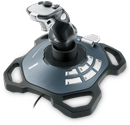While your keyboard and mouse supply the perfect way to play most strategy, simulation, and role-playing games (RPG), as well as the majority of first-person shooters, many other titles require a peripheral that offers more precise control.
Not sure where to start? Don’t worry; we’ll walk you through this.
An overview
![]() Most game peripherals connect to your Macintosh computer via a USB port and don’t require the installation of additional software to make them work, aside from any drivers that you may not have.
Most game peripherals connect to your Macintosh computer via a USB port and don’t require the installation of additional software to make them work, aside from any drivers that you may not have.
![]() If you’re not sure if you have the proper drivers, check the information that came with your controller to find out what you need. You can usually install any missing software from the CD that may have accompanied it, the manufacturer’s website, or by running Software Update.
If you’re not sure if you have the proper drivers, check the information that came with your controller to find out what you need. You can usually install any missing software from the CD that may have accompanied it, the manufacturer’s website, or by running Software Update.
Other than that, game controllers are basically plug-and-play. In most games, making a controller work is simply a matter of connecting your controller and then entering the Options menu (or the equivalent) in the game and selecting it. Many games also allow you to remap game functions, which means that, for example, if a certain button makes your character jump, you can remap the jump action to another button and use that one for a different action (such as shooting a weapon).
 If you need an application to help you manage a variety of game peripherals, check out USB Overdrive. It allows you to configure a device globally (for example, the jump action can be mapped to a certain button in all games) or for each game individually.
If you need an application to help you manage a variety of game peripherals, check out USB Overdrive. It allows you to configure a device globally (for example, the jump action can be mapped to a certain button in all games) or for each game individually.


